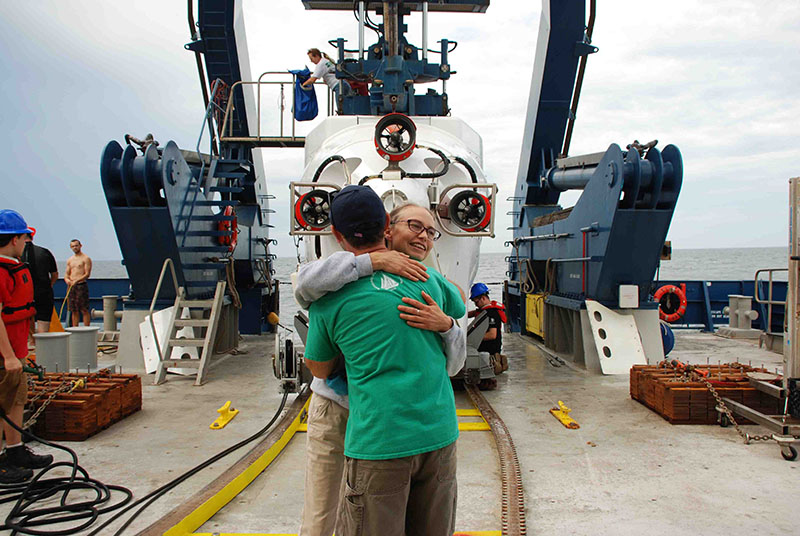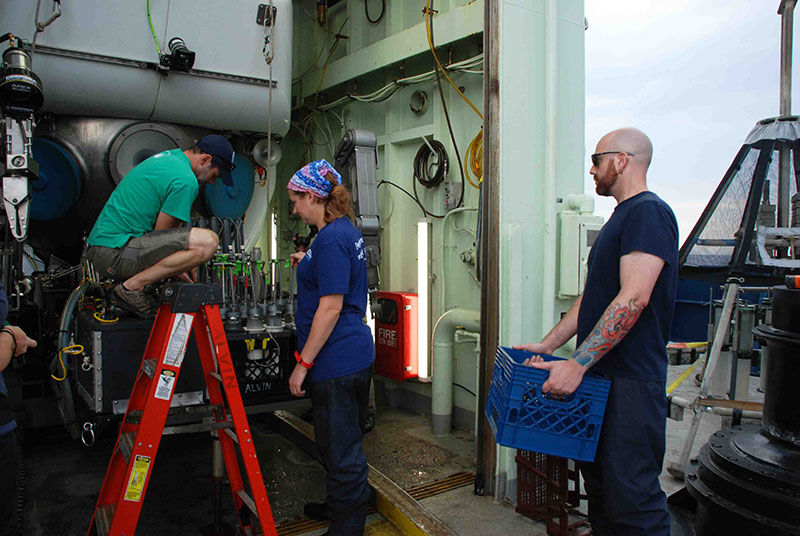
By Caitlin Adams, Web Coordinator, NOAA Office of Ocean Exploration and Research
August 21, 2018
Today was exactly the type of dive that the DEEP SEARCH science team has been readying for over the last few months. All of the packing, the protocol reviewing, and the sample designing went from preparation to application the instant Alvin arrived on deck this afternoon. With a completely loaded basket of pushcores, samples in the biobox and quivers, and Niskin bottles, it was all hands on deck to unload—and fully process—everything that arrived.
Because we’re planning to dive every day and only have a certain amount of each type of customized sampling equipment on board, we must be sure to get all the samples processed and safely stored as soon as possible so that the Alvin team can begin resetting the sampling basket for the next dive.

Mandy Joye and Erik Cordes hug after a successful Alvin dive to an active methane seep environment. Image courtesy of DEEP SEARCH 2018 - BOEM, USGS, NOAA. Download larger version (jpg, 1.7 MB).

As it was Chris Kellogg’s first Alvin dive, her colleagues Sandra Brooke and Cheryl Morrison celebrated her milestone in the customary way: with an ice bath. Image courtesy of DEEP SEARCH 2018 - BOEM, USGS, NOAA. Download larger version (jpg, 4.4 MB).
Professor Mandy Joye and United States Geological Survey scientist Chris Kellogg led today’s dive, which was the first human exploration of the Pea Island seeps—named for the Outer Banks island that’s the nearest onshore location. On the seafloor, they found spectacular mats of Beggiatoa bacteria, which feed off the methane seeping through the sediment. They also saw a large field of quill worms scattering the muddy, soft bottom environment.
That muddy seafloor also provided the perfect opportunity to collect some core samples—and sample they did! When the Alvin surfaced nearly nine hours after launch, 33 pushcores filled with seafloor sediment surfaced with it. All five Niskin bottles had been filled with seawater and a small collection of biological (quill worms, crab legs, sea stars) and geological (carbonate rock) samples were aboard as well.
It’s often about an hour from the time Alvin reaches the sea surface to the time it’s fully secured in its hangar on deck; in that span, a small boat meets the sub at the surface, swimmers secure a cable from the A-frame to the sub, the A-frame lifts the sub onto the deck, the crew rinses the sub with freshwater, the scientists and pilot climb out of the sub while it’s still on the aft deck, and then the sub is moved along its track back into its hangar. Through that whole evolution, the vast majority of the science team is watching from a safe distance on the back deck, anxiously waiting to unload the sampling basket. The minute the sub hits the hangar, everyone swarms to inspect the samples. The pushcores, packed in groups of 12 in milk crates, are lifted out and swiftly brought to one of the two cold storage rooms on the main deck, as is the Niskin bottle rack. The bioboxes are visually inspected for their contents and transported to the second cold room.

Erik Cordes unloads the Alvin sample basket as Jennie McClain-Counts and Jonathan Quigley stand by, ready to haul a crate of pushcores back to the cold room. Image courtesy of DEEP SEARCH 2018 - BOEM, USGS, NOAA. Download larger version (jpg, 1.5 MB).
From there, science teams work to process their samples. Each group has different protocols, so samples are split amongst the teams, and they all work as long as it takes to collect, analyze, and store the samples. With such a large number of pushcores from our first dive, the so-called mud teams, the Demopoulos and Joye labs, had quite a task before them—the initial processing took both groups until the early morning, and then there’s still a lot more analysis to be done in the coming days. Finally, at least one volunteer is needed to wash the equipment—in this case, Bureau of Ocean Energy Management representative Mike Rasser gamely jumped in—so that it can be reset for the next dive.

When the CTD was hauled back onto the deck, the DEEP SEARCH team immediately got to work taking water fractions. The Joye, Cordes, Demopoulos, and Prouty labs are all analyzing water from each CTD cast. Image courtesy of DEEP SEARCH 2018 - BOEM, USGS, NOAA. Download larger version (jpg, 4.9 MB).
Sampling wasn’t over then, though. Two CTD casts were also completed in the vicinity of the dive. Each CTD rosette contains 24 10-liter Niskin bottles that are specially designed to collect water and seal when tripped at depth. The rosette is controlled by a computer program that allows the scientists to see full ocean depth profiles of water column data, including temperature and salinity, and then they can control the release of each bottle to collect water at certain depths.
With so many scientists onboard, a number of teams want water samples from each bottle, and our first day of CTD sampling was a busy one. I know that I, at least, was up until midnight filtering water for Amanda Demopoulos to determine particulate organic matter (a measure of how much microscopic organic material, or food, is in the seawater). Many others, especially those in the Joye Lab, were up far later doing more complex microbial analyses. It was a frenetic, science-filled night, and it was a great reminder of how quickly the pace of life-at-sea can change. You can have a relaxed eight hours while the sub is on the seafloor, but you’ll have a far busier eight (or more!) hours working after it returns.

After overnight multibeam mapping data collection over the Pea Island seeps, Jason Chaytor reviewed the data for evidence of methane bubble plumes in the water column. Image courtesy of DEEP SEARCH 2018 - BOEM, USGS, NOAA. Download larger version (jpg, 1.4 MB).
Check back in the coming days for logs from some of the scientists onboard who will be telling you more about what exactly they do with the samples we’re collecting out here!